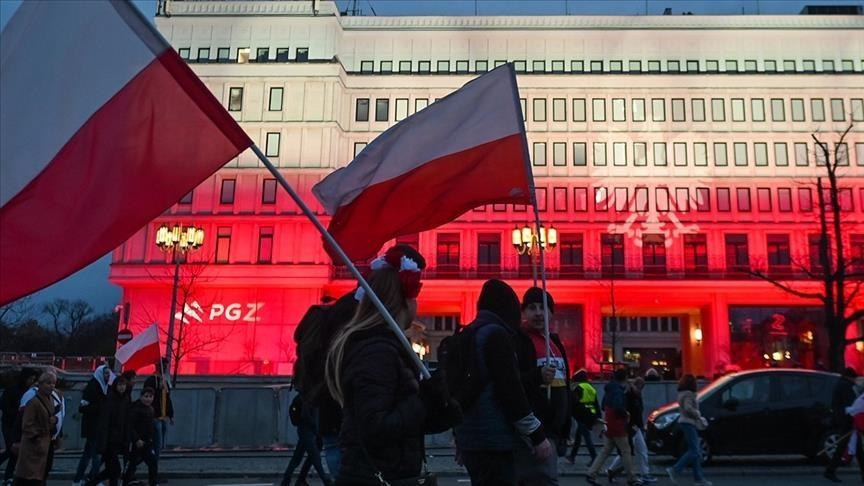Ukraine war’s shadow pushes Poland into European spotlight
Past and present remain powerful influences as Poland takes center stage in a region roiled by war

WARSAW
As Ukraine looks toward the West, Europe’s geopolitical center of gravity is shifting eastward, with US President Joe Biden’s February visit to Poland sending a clear signal that Warsaw is now at least as crucial to Washington as Berlin and Paris.
“The balance of diplomatic power is certainly tipping toward east-central Europe,” Pawel Markiewicz, executive director of the Polish Institute of International Affairs Office in Washington, told Anadolu.
“Warsaw’s reaction to the war in Ukraine – both in the humanitarian and military-political contexts – indicates that Poland is stepping up its regional and European roles … it’s serious about defending its European partners.”
The ongoing war in Ukraine and events in Russia, with potential ripple effects in Belarus, are dynamically recalibrating the geopolitical landscape in Eastern Europe. At stake are potentially the future shape and form of the EU itself, as well as NATO.
France and Germany have lost some influence in Washington due to their involvement in the Normandy Format talks with Russia, which many argue led to the Minsk Agreements and set the stage for the full-scale war in Ukraine. Berlin’s failure to consider the Nord Stream 2 gas pipeline as a strategic mistake also dented its credibility.
“On the Ukraine war, clearly Poland, the Baltics and the Scandinavians are mostly engaged, but for Atlantic countries such as Ireland, Spain and Portugal it is relatively far away geopolitically and rather peripheral – it could be the Falklands,” said Albrecht Rothacher, a former EU diplomat, author and political analyst.
“So the eastern shift in EU decision-making by national engagement is clearly there,” he said.
‘Largest military power between Russia and France’
Since the war began in February 2022, Poland has registered more than 1.5 million Ukrainian refugees, drawing praise from Western powers.
Just last week, US Ambassador Mark Brzezinski hailed Poland as a “humanitarian superpower,” capable of leading post-war reconstruction efforts in Eurasia.
“This is a catalytic moment that could reshape not only Central and Eastern Europe, but the whole Eurasian area,” he said at a conference organized by the American Chamber of Commerce in Poland.
Simultaneously, Poland has significantly increased its defense budget, allocating 4% of its GDP, double the NATO requirement.
The share of Polish military spending dedicated to procurement rose from 20.4% to 35.9% in 2022, according to official data.
As the third-highest contributor to Ukraine, behind the US and UK, Poland has supplied hundreds of tanks, armored vehicles, missile and rocket systems, and artillery pieces.
Recognizing that a close partnership with the US is essential to deter Russia, Poland has pushed for permanent American military presence on its territory since joining NATO in 1999.
Currently, around 10,000 US soldiers are stationed in Poland, an increase of 6,000 since last year. Poland’s own army is expected to grow to 300,000 professional soldiers and 50,000 civil defense personnel in the coming years.
Poland’s efforts to strengthen its military capabilities include the big-money purchase of Abrams tanks, HIMARS rocket launchers, and other high-grade weapons from the US.
Warsaw has also proposed becoming the maintenance hub for Abrams tanks deployed in Europe, while Polish factories are already repairing Ukrainian artillery and armor for reuse on the front lines.
Additionally, Poland has received its first shipment of tanks and howitzers from South Korea and is also acquiring 48 FA-50 light combat fighter jets.
Rothacher said money from the NextGenerationEU fund, originally intended for post-COVID recovery, will allow Poland “to shift funds to massively purchase arms and military material from the US and South Korea, and hence to emerge as the largest military power between Russia and France.”
Burden of history
Poland’s history is marked by struggles against Russia, both during its Tsarist and Soviet eras.
Partitioned by Russia for 128 years, Poland re-emerged in 1918. Failed uprisings against Russian rule in 1831 and 1863 were met with repression and expulsions.
Since joining the EU in 2004, Poland repeatedly warned of the threat posed by a resurgent Russia and has been at the forefront of calls for tougher sanctions against Moscow.
Pro-Kremlin media has accused Poland of planning to attack Belarus and Ukraine.
Issues of unresolved historical events remain, such as the mass murder of Poles in Volhynia in 1943 and East Galicia in 1944 by nationalist Ukrainian partisans.
Polish retaliation resulted in the deaths of an estimated 20,000 to 25,000 Ukrainians in the Chelm region, and these conflicts led to the expulsion of some 800,000 Poles from what is now western Ukraine and about 500,000 Ukrainians from eastern Poland.
Tensions over historical events resurfaced when the conservative Law and Justice (PiS) party won the elections in 2015, challenging Ukraine’s reluctance to recognize Polish suffering.
Despite the tensions, though, Polish-Ukrainian relations have improved significantly.
A survey published by the daily Rzeczpospolita in April showed nearly 80% of Poles view the relationship positively.
Ukrainian President Volodymyr Zelenskyy’s visit in April acknowledged the apprehensions, but some fear that the rise of Polish far-right parties, like Confederation, could pressure the PiS to ensure that the burden of history is not forgotten.
“The upcoming NATO summit will be a critical event for the future of the transatlantic security architecture,” said Markiewicz, referring to the high-stakes gathering kicking off in Lithuania next week.
“Unfortunately, I don’t expect to see the alliance welcoming Ukraine into its structures just yet.”
Anadolu Agency website contains only a portion of the news stories offered to subscribers in the AA News Broadcasting System (HAS), and in summarized form. Please contact us for subscription options.







